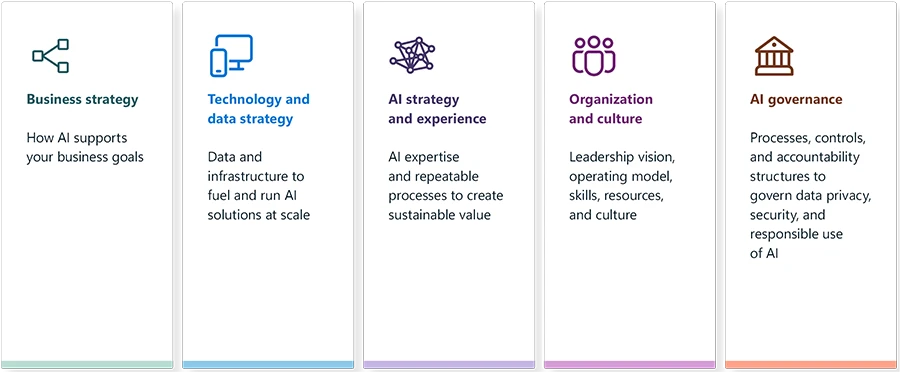
Innovating at the speed of AI: Microsoft’s industry Copilot solutions
Our industry-specific solutions enable businesses to adopt and integrate AI technologies swiftly and efficiently.

AI has come a long way since John McCarthy coined the term at the Dartmouth conference in 1956.1 Since then, we’ve seen multiple waves of innovation, from machine learning to neural networks and, of course, generative AI. Today we are in the midst of a platform shift that is changing the way we live and work. The challenge and the opportunity for leaders is to lay the groundwork today that will enable your organization to deliver value from AI in the months and years to come.
The AI Strategy Roadmap shares what Microsoft has learned about the emerging best practices that organizations are using to create sustainable value with AI, as well as actionable insights to help you focus on the steps that are most likely to drive results. Here are some of the questions we sought to answer with this research:
We worked with Ipsos to survey more than 1,300 business and technology decision makers across multiple regions and industries. Ipsos then built a predictive model, using advanced analytics, to identify the most powerful factors that affect time to value.

The result is a set of evidence-based best practices intended to help you build your AI roadmap or pressure-test your existing plan with confidence. Here are some of the highlights.
AI technology is more powerful than it’s ever been, and the pace of innovation is humbling. Yet the ability to realize value from AI depends as much on strategic, organizational, and cultural factors as it does on technology.
Part one of the e-book offers deep insights into the five drivers, introduced in Building a Foundation for AI Success, that contribute to an organization’s ability to deliver value with AI.

Given the diversity among organizations in terms of size, age, region, industry, and other attributes, there is no “one size fits all” roadmap. Our research describes five stages of AI readiness, from organizations just getting started to those already realizing sustainable and measurable value from AI at scale. The chart below lays out the descriptions of each stage, along with corresponding profile data.

Microsoft Cloud
Learn moreYou’ll note that organizations at the exploring and planning stages tend to be older and less likely to be cloud-first, compared to those at the realizing stage. We also saw corresponding trends related to the organization’s success at realizing significant value from AI; 3% at the exploring stage, compared with 96% at the realizing stage. So it became clear that we needed to look not only at what leaders should be prioritizing to optimize for AI, but when.
We needed to look not only at what leaders should be prioritizing to optimize for AI, but when.
Part two of the e-book includes guidance to help you map your strategy and identify the highest-impact actions based on your organization’s stage of readiness and unique needs.
In the exploring stage, for example, the primary focus is on AI strategy and experience, as learning about and ideating on potential AI use cases is the best way to build momentum.
As organizations move to the planning stage, the focus shifts to business strategy (to prioritize use cases and ensure they map to business objectives) and technology and data readiness (to ensure the organization has access to the data and infrastructure needed to run large AI models at scale).
In the implementation stage, and throughout the scaling and realizing stages, the priority shifts to organization and culture. This reflects the fact that, by now, some of the critical groundwork needed to deploy AI projects is in place, and enablement is the next priority. This includes steps such as identifying AI experts, defining an operating model, and, most importantly, securing the leadership vision and support needed to deliver sustainable value.
While efficiency and productivity will always be paramount, organizations at the realizing stage focus on growth-oriented objectives—such as customer experience and product and service innovation—at almost twice the levels of those in the exploring stage.
A leader-driven AI strategy is most strongly associated with AI value creation. One hundred percent of senior leaders of organizations at the realizing stage have clearly communicated their commitment to AI compared to 6% at the exploring stage. We also saw that, as organizations reach the more advanced stages, they become more likely to add a chief AI officer (CAIO) to their executive team. By the time they’ve reached the realizing stage, nearly two-thirds have appointed a CAIO.
The AI Strategy Roadmap lays out the most effective steps you can take to build momentum toward your goals, based on your organization’s stage of readiness. We hope the insights we’ve shared help you lay the foundation for sustainable AI innovation, accelerate your organization’s time to value, and help you achieve more in the age of AI.
For more information on how to accelerate your path to value with AI, please download The AI Strategy Roadmap: Navigating the stages of AI value creation.
1The Meeting of the Minds That Launched AI, IEEE Spectrum.